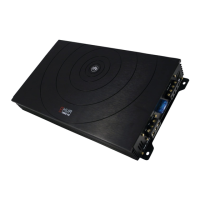
Do you have a question about the DB Drive Okur A3 Series A3 1500.1D and is the answer not in the manual?
| Channels | 1 |
|---|---|
| RMS Power @ 4 Ohms | 500W |
| RMS Power @ 1 Ohm | 1500W |
| Power Output (Peak) | 3000W |
| Frequency Response | 10Hz - 250Hz |
| Signal to Noise Ratio | >90dB |
| Input Sensitivity | 200mV - 6V |
| Crossover Type | Low-Pass |
| Low-Pass Crossover Frequency | 40Hz - 180Hz |
| Subsonic Filter | 10Hz - 50Hz |
| Fuse Rating | 150A |
| Amplifier Class | D |
| Operating Voltage | 9V - 16V |
| Efficiency | >85% |
| RMS Power @ 2 Ohms | 800W |
| Phase Shift | 0 - 180 degrees |
| Bass Boost | 0 - 12dB |
Specifications for the DB Drive A3 80.4 amplifier model.
Specifications for the DB Drive A3 1500.1D amplifier model.
Specifications for the DB Drive A3 1000.1D amplifier model.
Adjusting amplifier gain to match the radio's output for optimal sound.
Connect the amplifier's main power wire to the car's battery.
Connect the amplifier's ground wire to the car's chassis.
Connect the remote turn-on wire for amplifier power control.
Protects speakers from DC voltage by shutting down the amplifier.
Protects the amplifier from speaker or wiring shorts.
Protects amplifier from overheating by shutting it down.
Diagnostic LED indicating when the amplifier is on.
Built-in variable crossovers for low/high pass filtering.
Blocks for efficient power and signal transfer.
Variable bass boost for enhanced low frequencies.
Full range line outputs for connecting additional amplifiers.
Protects against short circuits and excessive current.
Automatically turns amplifier on/off with the head unit.
Fine-tunes level matching between source and amplifier.
Details stable operation at low impedances for specific models.
Fuse the power wire within 12" of the car's battery for protection.
Use high grade connectors for maximum power transfer and secure connections.
Run wires through interior panels to prevent damage and ensure clean installation.
Be careful when mounting to avoid puncturing vehicle lines or drilling into gas tank.
Run signal wires away from electrical wiring to avoid induced noise.
Keep ground wires short and connect at the same point to reduce noise and resistance.
Protect wires from sharp edges with grommets to prevent shorts.